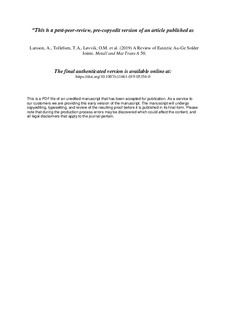| dc.contributor.author | Larsson, Andreas | |
| dc.contributor.author | Tollefsen, Torleif Andre | |
| dc.contributor.author | Løvvik, Ole Martin | |
| dc.contributor.author | Aasmundtveit, Knut | |
| dc.date.accessioned | 2019-11-25T13:26:10Z | |
| dc.date.available | 2019-11-25T13:26:10Z | |
| dc.date.created | 2019-09-19T11:59:53Z | |
| dc.date.issued | 2019 | |
| dc.identifier.citation | Metallurgical and Materials Transactions. A. 2019, 50 (10), 4632-4641. | nb_NO |
| dc.identifier.issn | 1073-5623 | |
| dc.identifier.uri | http://hdl.handle.net/11250/2630341 | |
| dc.description.abstract | Gold-germanium (Au-Ge) joints have been part of the electronics industry since the birth of the solid state transistor. Today they find their role as a reliable joining technology, especially for high-temperature applications. This article is a literature study reviewing Au-Ge joints: Their uses, properties, material compatibility, application techniques, and performance characteristics. The review concludes that it is possible to create high-quality and very strong Au-Ge joints with a shear strength up to 150 MPa. They are stable and reliable, showing limited degradation after thousands of hours at high temperature and thousands of thermal cycles. Joints may be used in low-stress applications up to 300 °C. | nb_NO |
| dc.language.iso | eng | nb_NO |
| dc.title | A Review of Eutectic Au-Ge Solder Joints | nb_NO |
| dc.type | Journal article | nb_NO |
| dc.type | Peer reviewed | nb_NO |
| dc.description.version | acceptedVersion | nb_NO |
| dc.source.pagenumber | 4632-4641 | nb_NO |
| dc.source.volume | 50 | nb_NO |
| dc.source.journal | Metallurgical and Materials Transactions. A | nb_NO |
| dc.source.issue | 10 | nb_NO |
| dc.identifier.doi | 10.1007/s11661-019-05356-0 | |
| dc.identifier.cristin | 1726660 | |
| cristin.unitcode | 222,58,4,0 | |
| cristin.unitname | Institutt for mikrosystemer | |
| cristin.ispublished | true | |
| cristin.fulltext | original | |
| cristin.qualitycode | 2 | |
